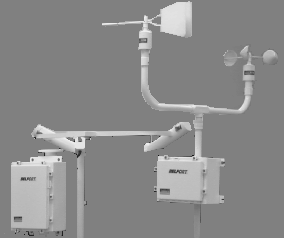a. Time used in Reports. With the exception of designated stations
which transmit reports in accordance with agency instructions,
METAR shall
be transmitted at fixed intervals with SPECI
transmitted when any of the criteria listed on
page 4 (SPECI) occurs or is noted.
| (1) | Accuracy of Time in Reports.
A procedure shall be established to assure that the accuracy of the timing
device used to establish times in the observation program are within ±1 minute
of the Coordinated Universal Time as determined by the U.S. Naval Observatory.
|
| (2) | Scheduled Time of Report.
The scheduled time of the METAR shall be the
Coordinated Universal Time (UTC) a
METAR is required to be available for
transmission. |
| (3) | Actual Date and Time of
Observation. The actual date and time of
METAR shall be the time the last
element of the observation was observed. The actual time of a
SPECI shall be
the time the criteria for the SPECI was met or noted. |
| (4) | Time Disseminated in
Observations. All times disseminated in observations shall reference the
24-hour UTC clock; e.g., 1.47 A.M. shall be referred to as 0147 and 1:47 P.M.
as 1347. The times 0000 and 2359 shall indicate the beginning and ending of
the day, respectively. |
| (5) | Date and Time entered in
Observations. All dates and times entered in observations shall be with
reference to the 24-hour clock. The times that are disseminated as part of the
observation shall be entered in UTC. However, at the discretion of the
responsible agency, those times used to otherwise document the observation or
other related observational data may be either Local Standard Time (LST) or
UTC. The time standard selected shall be clearly indicated on all records; if
LST is used, the number of hours used to convert to UTC shall also be indicated.
|
4. Recency of Observed Elements at Automated Stations.
Individual elements entered in an observation shall, as closely as possible,
reflect conditions existing at the actual time of observation. For those
elements that the human observer evaluates using spatial averaging techniques
(e.g., sky cover and visibility), the automated station substitutes time
averaging of sensor data. Therefore, in an automated observation, sky
condition shall be an evaluation of sensor data gathered during the 30-minute
period ending at the actual time of the observation. All other elements shall
be based on sensor data that is within 10 minutes or less of the actual time of
the observation.
5. Recency of Observed Elements at Manual Stations.
Individual elements entered in an observation shall, as closely as possible,
reflect conditions existing at the actual time of observation. Elements
entered shall have been observed within 15 minutes of the actual time of the
observation. Gusts and squalls shall be reported if observed within 10 minutes
of the actual time of the observation. Observation of elements shall be made
as close to the scheduled time of the observation as possible to meet filing
deadlines, but in no case shall these observations be started more than 15
minutes before the scheduled time.
6. Corrections to Transmitted Data.
Corrections shall be disseminated, as soon as possible, whenever an error is
detected in a transmitted report. However, if the erroneous data has been
superseded by a later report (with the same or more complete dissemination), it
shall not be necessary to transmit the corrected report. Corrections
transmitted shall consist of the entire corrected report. The original date
and time of the report.
7. Report Filing Time.
SPECIs shall be completed and transmitted as soon as possible. Agencies shall
establish filing deadlines for all METARs. The
filing deadlines shall be no
sooner than necessary to assure the availability of the report at its scheduled
time. METARs shall not be transmitted sooner
than 10 minutes before their scheduled time.
8. Delayed Reports.
When transmission of an observation is delayed until time for the next
regularly scheduled report, only the latest report shall be transmitted. In
the record of observations, the remark FIBI (Filed But Impractical to
Transmit) shall be appended in parentheses to the report that was not
transmitted to indicate the report was not transmitted. The remark FIBI shall
not be included in any local dissemination of the report.
When a SPECI is not transmitted long-line, the
later SPECI shall be transmitted long-line only
when the overall change between the last transmitted report and the current
report satisfies the criteria for a SPECI. If the
SPECI is not transmitted long-line, the remark
FIBI shall be appended to the report in the record of observations. The
SPECI shall be disseminated locally.
Reports of Volcanic Eruption shall be disseminated, by any means
possible, regardless of the delay.

